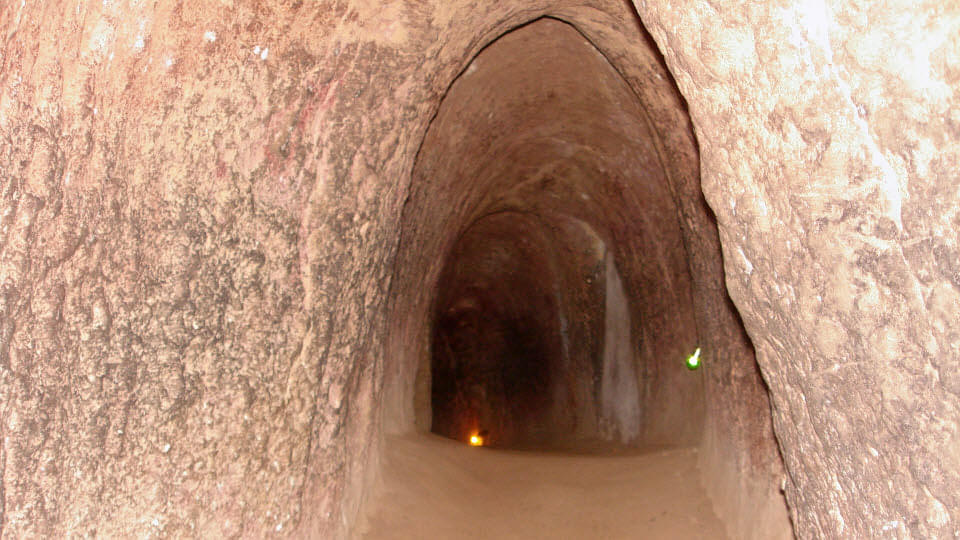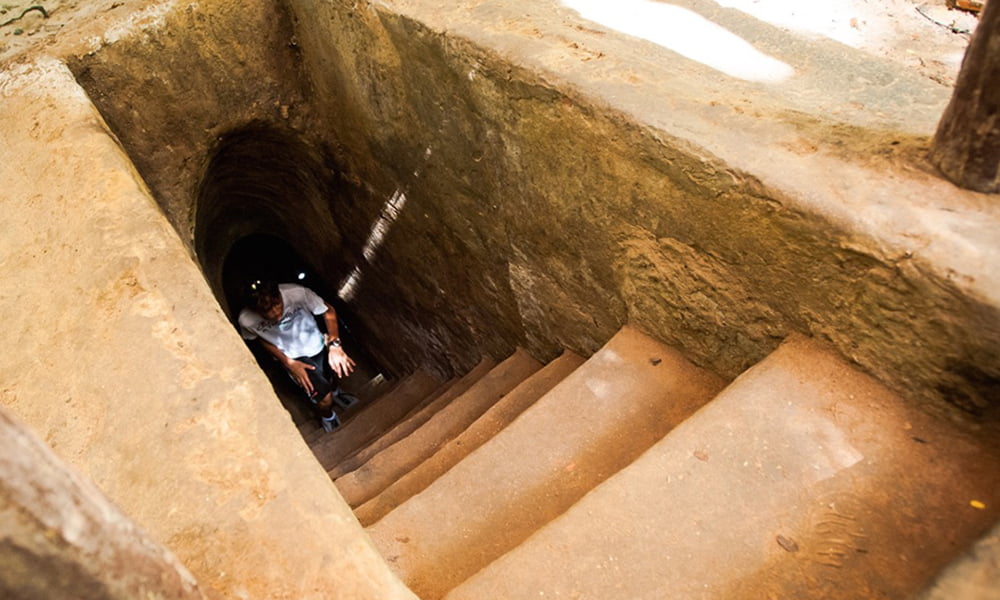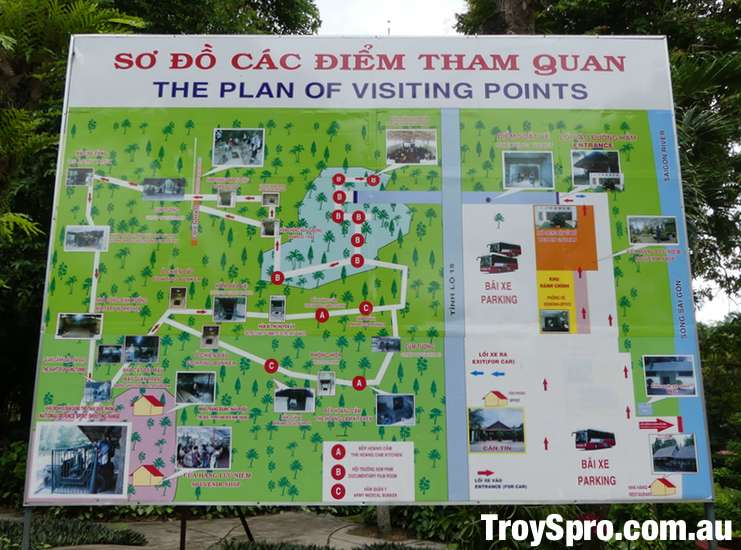Table of Contents
Deep beneath the lush rice paddies and dense jungle terrain of Cu Chi tunnel Ho Chi Minh, a network of underground tunnels, bunkers, and chambers served as a resilient sanctuary for Vietnamese soldiers and civilians during the Vietnam War. The Cu Chi Tunnels, a testament to human ingenuity and determination, played a pivotal role in the conflict, becoming a symbol of Vietnamese resistance and resilience.
Location and Layout of Cu Chi Tunnel: A Maze Beneath the Surface

Situated approximately 40 kilometers northwest of Ho Chi Minh City, the Cu Chi tunnel Ho Chi Minh extend over an area of more than 200 square kilometers, stretching from Cu Chi District to Ben Cat District. The intricate network of tunnels is believed to have been constructed over decades, initially used as a means of communication and transportation by local villagers.
During the Vietnam War, the tunnels were significantly expanded and fortified by the Viet Cong, transforming them into a vast underground complex. The tunnels were meticulously designed, featuring multiple levels and interconnected chambers, with narrow passages and hidden entrances concealed amidst the dense vegetation. Ventilation systems and water sources were carefully planned to sustain life underground, while booby traps and hidden chambers added an element of surprise against enemy forces.
Map of Cu Chi Tunnel Network
| Map of Cu Chi Tunnel Network |
Purpose and Construction of Cu Chi Tunnel: A Strategic Advantage

The Cu Chi Tunnels were initially built by the Vietnamese people as a means of defense against foreign invaders. However, during the Vietnam War, they became an essential tool for the Viet Cong to fight against American and South Vietnamese forces. The tunnels provided a strategic advantage, allowing the Viet Cong to move undetected and launch surprise attacks on their enemies.
The construction of the tunnels was a massive undertaking, involving thousands of workers and volunteers. The Viet Cong used simple tools such as shovels, hoes, and bamboo baskets to dig the tunnels, which were often done at night to avoid detection. The soil removed from the tunnels was used to create bunkers and camouflage for the entrances, making it difficult for the enemy to locate them.
Comparison between Cu Chi Tunnel and other Tunnels
| Comparison between Cu Chi Tunnel and other Tunnels |
Life in Cu Chi Tunnel during the War: A Story of Survival

Life in the Cu Chi tunnel Ho Chi Minh was not easy, but the Vietnamese people showed remarkable resilience and determination to survive. The tunnels were cramped, dark, and infested with insects and rodents. The lack of proper ventilation and sanitation made living conditions challenging, and diseases were rampant.
Despite these challenges, the people of Cu Chi persevered, using their resourcefulness to adapt to life underground. They created makeshift kitchens, hospitals, and schools within the tunnels, and even managed to grow crops and raise livestock to sustain themselves. The tunnels also served as a hiding place for women and children during air raids, providing a sense of safety amidst the chaos of war.
Survival Tactics used in Cu Chi Tunnel
- Camouflage: The entrances to the tunnels were carefully disguised to blend in with the surrounding environment, making it difficult for the enemy to locate them.
- Booby Traps: The Viet Cong set up various booby traps, such as spike pits and tripwires, to protect the tunnels from enemy attacks.
- Secret Entrances: The tunnels had multiple hidden entrances, some of which were only accessible through small holes or trapdoors, making it challenging for the enemy to enter.
- Communication Systems: The Viet Cong used a series of coded knocks and signals to communicate within the tunnels, ensuring secrecy and security.
Impact of Cu Chi Tunnel on the Vietnam War: A Turning Point

The Cu Chi Tunnels played a significant role in the outcome of the Vietnam War. They provided a safe haven for the Viet Cong, allowing them to launch surprise attacks and evade capture by American forces. The tunnels also served as a supply route for weapons and food, keeping the Viet Cong well-equipped and nourished.
The American military recognized the strategic importance of the Cu Chi Tunnels and launched several unsuccessful attempts to destroy them. However, the Viet Cong’s determination and resilience prevailed, and the tunnels remained intact, serving as a symbol of their unwavering spirit and resistance against foreign invaders.
Tourism at Cu Chi Tunnel Today: A Journey through History

Today, the Cu Chi Tunnels have become a popular tourist attraction, drawing thousands of visitors each year. Tourists can explore a section of the tunnels that have been widened and reinforced for safety purposes. Visitors can also see various traps and weapons used during the war, providing a glimpse into the harsh realities of life underground.
Facts and Figures about Cu Chi Tunnel
| Facts and Figures about Cu Chi Tunnel |
Controversies surrounding Cu Chi Tunnel: A Complex Legacy

Despite its historical significance, the Cu Chi Tunnels have also faced controversies. Some critics argue that the tunnels have been commercialized and turned into a tourist trap, with little regard for the sacrifices made by the Vietnamese people during the war. Others believe that the tunnels glorify the Viet Cong and downplay the atrocities committed by both sides during the conflict.
However, many argue that the Cu Chi Tunnels serve as a reminder of the horrors of war and the resilience of the Vietnamese people. It is a place where visitors can learn about the country’s history and honor the sacrifices made by those who fought for their freedom.
Video

Conclusion: A Testament to Human Ingenuity and Resilience
The Cu Chi tunnel Ho Chi Minh are more than just a network of underground passages; they are a symbol of the enduring spirit and resilience of the Vietnamese people. They stand as a testament to human ingenuity, determination, and perseverance in the face of adversity. The tunnels have played a pivotal role in the Vietnam War and continue to be a significant part of the country’s history and identity. Visiting the Cu Chi Tunnels is not just a journey through history, but also a tribute to the unwavering spirit of the Vietnamese people.